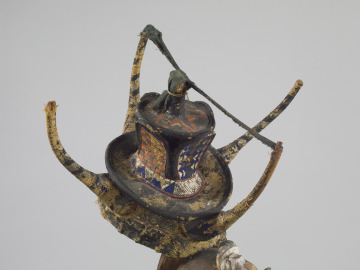Mask
- Artist Culture
- Yaka artist
- Date
- early 20th century
- Material
- Wood, fiber, pigment
- associated with
- Bandundu province, Central Africa, Congo, Africa
- Classification
- Costume & clothing, masks
- Current Location
- On View, Gallery 117
- Dimensions
- 22 in. (55.9 cm)
- Credit Line
- Gift of Morton D. May
- Rights
- Contact Us
- Object Number
- 411:1955
NOTES
This mask displays a spectrum of colors, including white, black, red, blue, and orange, typically seen in Yaka arts. Kaolin, or white clay, enhanced the visibility of the mask. Blue and orange lines descending from the eyes might suggest the sufferings of a boy’s initiation into adulthood, such as circumcision or hazing.
Masks such as this appeared in pairs at celebrations marking the end of boys’ "n-khanda" initiation. Rather than wearing it over the head or face, the masquerader covered his face during performance by holding the wood handle protruding from the bottom. A ruff of raffia fibers descending from the wooden mask and its structured cloth crest would have concealed the dancer’s hand and forearm.
Provenance
by 1941 - 1955
Erhard Weyhe [Weyhe Gallery], New York, NY, USA [1]
1955
Morton D. May (1914-1983), St. Louis, MO, purchased from Erhard Weyhe [2]
1955 -
Saint Louis Art Museum, given by Morton D. May [3]
Notes:
[1] A document dated December 15, 1955 and signed by Morton D. May stated this object was "secured by the original expedition sent into Africa by Weyhe and was subsequently put on sale and display in 1941" [SLAM document files].
[2] An invoice dated January 28, 1955 from E. Weyhe to May documents the purchase of this object, listed as "Bayaka Mask" [May Archives, Saint Louis Art Museum].
[3] A letter dated January 30, 1956 from Charles Nagel, director of the City Art Museum, to May acknowledges the gift of this object as part of a larger donation [Director's Office, Donor Correspondence, Archives, Saint Louis Art Museum]. Minutes of the Administrative Board of Control of the City Art Museum, December 8, 1955.
Erhard Weyhe [Weyhe Gallery], New York, NY, USA [1]
1955
Morton D. May (1914-1983), St. Louis, MO, purchased from Erhard Weyhe [2]
1955 -
Saint Louis Art Museum, given by Morton D. May [3]
Notes:
[1] A document dated December 15, 1955 and signed by Morton D. May stated this object was "secured by the original expedition sent into Africa by Weyhe and was subsequently put on sale and display in 1941" [SLAM document files].
[2] An invoice dated January 28, 1955 from E. Weyhe to May documents the purchase of this object, listed as "Bayaka Mask" [May Archives, Saint Louis Art Museum].
[3] A letter dated January 30, 1956 from Charles Nagel, director of the City Art Museum, to May acknowledges the gift of this object as part of a larger donation [Director's Office, Donor Correspondence, Archives, Saint Louis Art Museum]. Minutes of the Administrative Board of Control of the City Art Museum, December 8, 1955.










